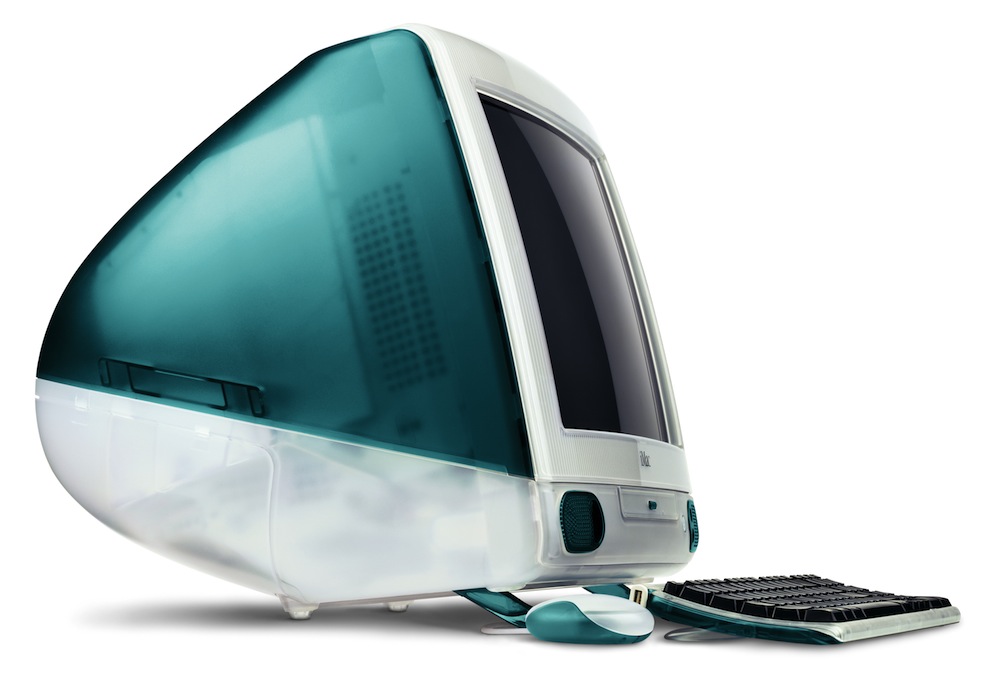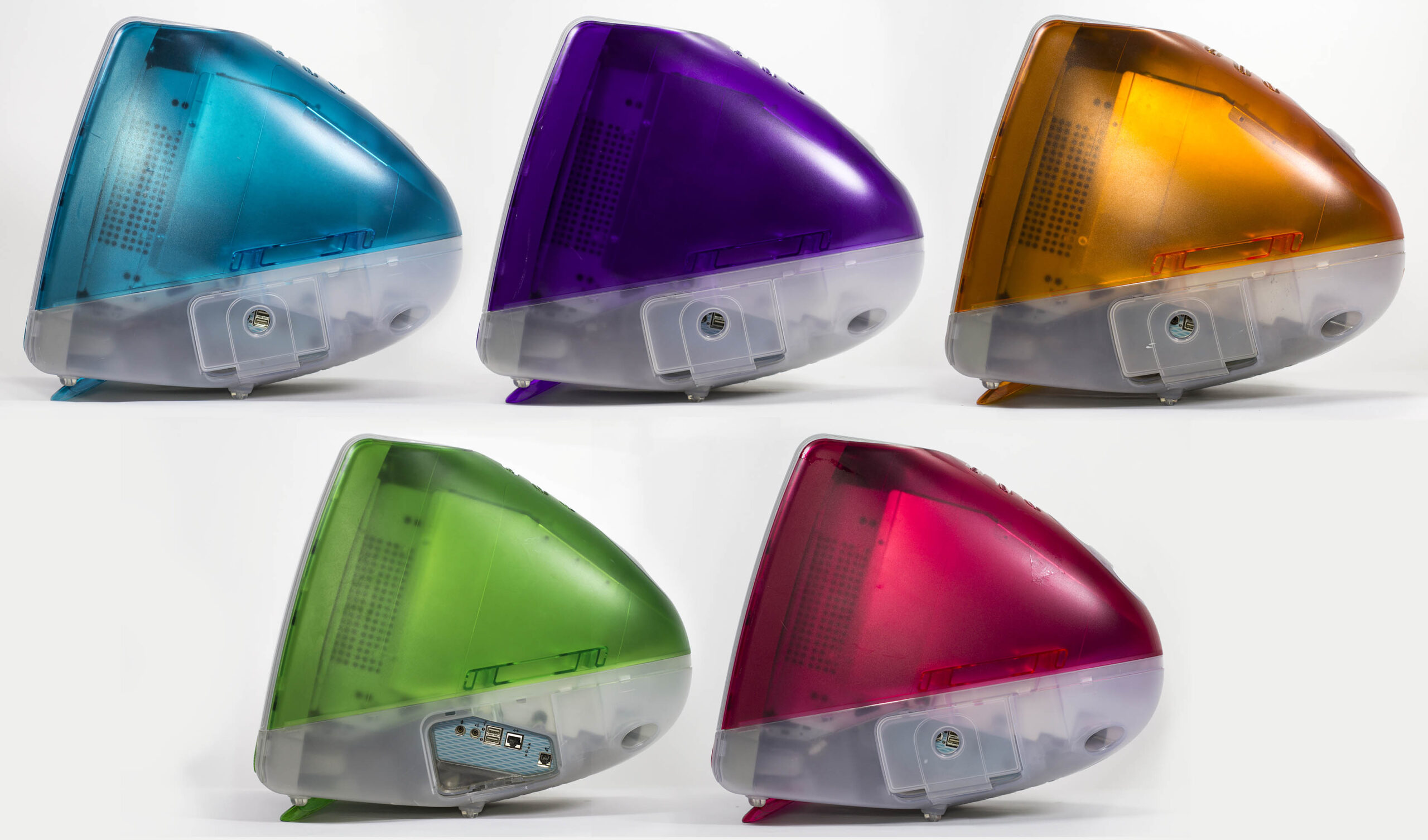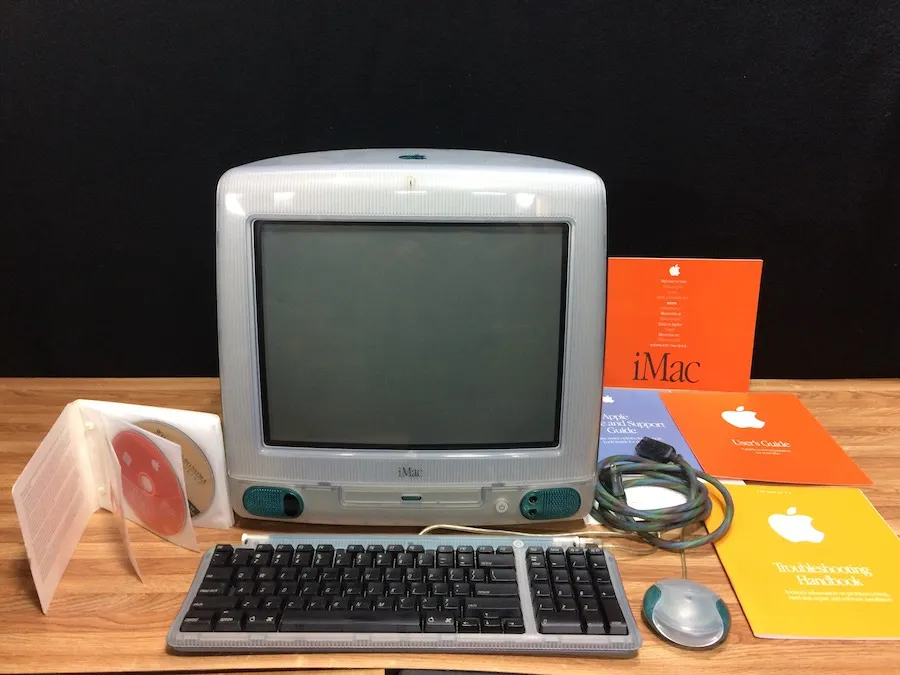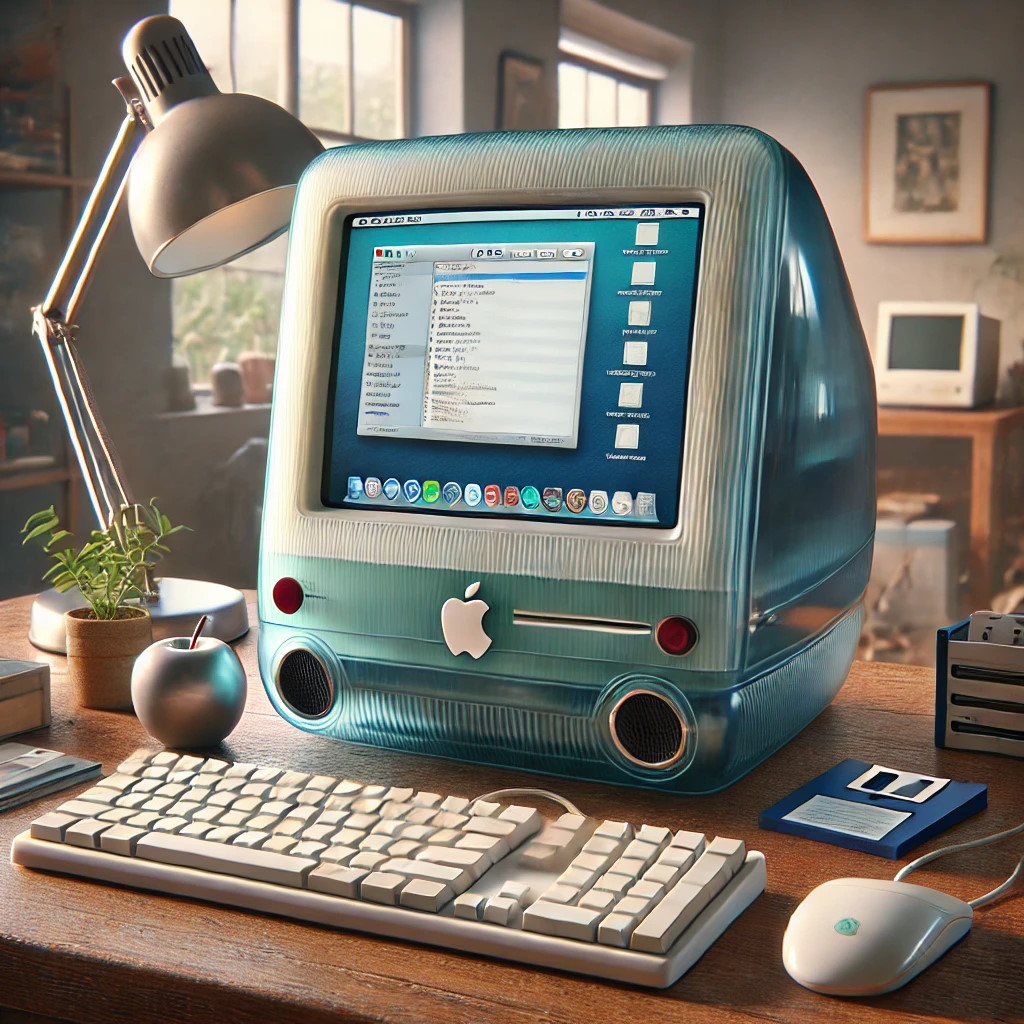iMac G3 – A Symbol of Late 90s PC Development
Introduction: A New Era in Personal Computing
In 1998, Apple introduced the iMac – a revolutionary computer that marked a new chapter in personal computing. Designed under the leadership of Steve Jobs and chief designer Jonathan Ive, it featured a striking translucent “Bondi Blue” case and an all-in-one form factor.

This was Apple’s first computer to eliminate the floppy disk drive, instead focusing on CD-ROMs and internet connectivity. The iMac G3 was not just about aesthetics—it was a bold statement of innovation.
Why It Stood Out
The iMac G3 captured attention with its vibrant design, making it more than just a computer—it was a fashion statement. Users loved its ease of use, especially its simple internet setup, which was crucial at the time. The all-in-one design saved space, and its competitive price made it accessible to a wider audience.
Criticism
Despite its innovations, the iMac G3 had its share of criticism. Many users were frustrated by the removal of the floppy disk drive, which was still widely used. The lack of legacy ports, such as SCSI and ADB, made it difficult to connect older peripherals.
Here’s a revised layout where each iMac G3 model has its own separate table, making it more readable while keeping all the details intact.
iMac G3 (233 MHz) – August 15, 1998
The first iMac G3 was a blend of power and design simplicity.
| Specification | Details |
|---|---|
| Processor | 233 MHz PowerPC G3 |
| Cache | 32 KB L1, 512 KB L2 |
| Memory | 32 MB SDRAM (expandable to 128 MB) |
| Graphics | ATI Rage IIc, 2 MB SGRAM |
| Hard Drive | 4 GB |
| Optical Drive | 24× CD-ROM (tray-loading) |
| Connectivity | 10/100 BASE-T Ethernet, 56k modem, 4 Mbit/s IrDA |
| Ports | 2× USB 1.1, audio in/out, built-in stereo speakers |
| Operating System | Mac OS 8.1 |
| Dimensions | 15.8 × 15.2 × 17.6 inches (40.1 × 38.6 × 44.7 cm) |
| Weight | 40 lb (17.25 kg) |
User Experience
Users praised the PowerPC G3 processor for its performance, which was considered powerful at the time. The Mac OS interface made the iMac G3 incredibly user-friendly, even for beginners.
However, the limited base RAM restricted performance for resource-heavy applications. The lack of a floppy drive was also a controversial decision, as many users still relied on floppy disks for file storage.
iMac G3 Updates
Apple continuously refined the iMac G3, introducing new colors, improved specifications, and additional features.
iMac G3 (266 MHz) – October 26, 1998
| Specification | Details |
|---|---|
| Processor | 266 MHz PowerPC G3 |
| Cache | 32 KB L1, 512 KB L2 |
| Memory | 32 MB SDRAM (expandable to 256 MB) |
| Graphics | ATI Rage Pro Turbo, 6 MB SGRAM |
| Hard Drive | 6 GB |
| Optical Drive | 24× CD-ROM (tray-loading) |
| Connectivity | 10/100 BASE-T Ethernet, 56k modem |
| Ports | 2× USB 1.1, audio in/out, built-in stereo speakers |
| Operating System | Mac OS 8.5 |
| Dimensions | 15.8 × 15.2 × 17.6 inches (40.1 × 38.6 × 44.7 cm) |
| Weight | 40 lb (17.25 kg) |
1999 Updates: More Colors & FireWire Support

In 1999, Apple expanded the iMac lineup with vibrant new color options: Tangerine, Grape, Blueberry, Lime, and Strawberry.
The graphics processor was upgraded to an ATI Rage 128 VR with 8 MB VRAM, and CPU speeds increased to 266–333 MHz. That same year, Apple launched the iMac DV, featuring digital video editing support, a 400 MHz processor, a DVD-ROM drive, and FireWire (IEEE 1394) ports.
iMac G3 (333 MHz) – January 5, 1999
| Specification | Details |
|---|---|
| Processor | 333 MHz PowerPC G3 |
| Cache | 32 KB L1, 512 KB L2 |
| Memory | 32 MB SDRAM (expandable to 256 MB) |
| Graphics | ATI Rage Pro Turbo, 6 MB SGRAM |
| Hard Drive | 6 GB |
| Optical Drive | 24× CD-ROM (tray-loading) |
| Connectivity | 10/100 BASE-T Ethernet, 56k modem |
| Ports | 2× USB 1.1, audio in/out, built-in stereo speakers |
| Operating System | Mac OS 8.5.1 |
| Dimensions | 15.8 × 15.2 × 17.6 inches (40.1 × 38.6 × 44.7 cm) |
| Weight | 40 lb (17.25 kg) |
iMac G3 (Slot Loading) – October 5, 1999
| Specification | Details |
|---|---|
| Processor | 350 or 400 MHz PowerPC G3 |
| Cache | 512 KB L2 |
| Memory | 64 MB SDRAM (expandable to 512 MB) |
| Graphics | ATI Rage 128 VR, 8 MB SDRAM |
| Hard Drive | 6 GB, 10 GB, or 13 GB |
| Optical Drive | CD-ROM, DVD-ROM, or CD-RW (slot-loading) |
| Connectivity | 10/100 BASE-T Ethernet, 56k modem, AirPort ready |
| Ports | 2× USB 1.1, 2× FireWire (except 350 MHz models), audio in/out, built-in stereo speakers, VGA video out (mirroring) |
| Operating System | Mac OS 8.6 |
| Dimensions | 15.0 × 15.0 × 17.1 inches (38.1 × 38.1 × 43.5 cm) |
| Weight | 34.7 lb (15.7 kg) |
User response
Users loved the fresh color options, making the iMac even more appealing, particularly among younger buyers. The addition of FireWire was a significant upgrade for professionals working with digital video.
However, despite improved performance, the lack of expandability remained a concern. The absence of traditional expansion slots made upgrading difficult.
2000–2001 Updates: More Power & Wireless Connectivity
By 2000, Apple further boosted the iMac’s performance. The iMac G3 SE models featured processors ranging from 400 to 500 MHz, increased RAM capacity to 64–128 MB, and larger 10–30 GB hard drives.
The graphics card was upgraded to ATI Rage 128 Pro or ATI Rage 128 Ultra, and Apple introduced AirPort (Wi-Fi 802.11b) support. The color lineup was also expanded with Ruby, Sage, Indigo, Snow, and Graphite.
iMac G3 (Summer 2000) – July 19, 2000
| Specification | Details |
|---|---|
| Processor | 350, 400, 450, or 500 MHz PowerPC G3 |
| Cache | 512 KB L2 |
| Memory | 64 MB SDRAM (expandable to 1 GB) |
| Graphics | ATI Rage 128 Pro, 8 MB SDRAM |
| Hard Drive | 7 GB, 10 GB, 20 GB, or 30 GB |
| Optical Drive | CD-ROM, DVD-ROM, or CD-RW (slot-loading) |
| Connectivity | 10/100 BASE-T Ethernet, 56k modem, AirPort ready |
| Ports | 2× USB 1.1, 2× FireWire, audio in/out, built-in stereo speakers, VGA video out (mirroring) |
| Operating System | Mac OS 9.0.4 |
| Dimensions | 15.0 × 15.0 × 17.1 inches (38.1 × 38.1 × 43.5 cm) |
| Weight | 34.7 lb (15.7 kg) |
iMac G3 (Early 2001) – February 22, 2001
| Specification | Details |
|---|---|
| Processor | 400, 500, or 600 MHz PowerPC G3 |
| Cache | 256 KB L2 |
| Memory | 128 MB SDRAM (expandable to 1 GB) |
| Graphics | ATI Rage 128 Pro, 8 MB SDRAM or ATI Rage 128 Ultra, 16 MB SDRAM |
| Hard Drive | 10 GB, 20 GB, or 40 GB |
| Optical Drive | CD-ROM, DVD-ROM, or CD-RW (slot-loading) |
| Connectivity | 10/100 BASE-T Ethernet, 56k modem, AirPort ready |
| Ports | 2× USB 1.1, 2× FireWire, audio in/out, built-in stereo speakers, VGA video out (mirroring) |
| Operating System | Mac OS 9.1 |
| Dimensions | 15.0 × 15.0 × 17.1 inches (38.1 × 38.1 × 43.5 cm) |
| Weight | 34.7 lb (15.7 kg) |
User response
The introduction of wireless networking was a game-changer, allowing users to ditch Ethernet cables for the first time. The increased RAM and processing power enabled the iMac G3 to stay competitive with other PCs.
However, professionals working with high-performance applications still found the graphics capabilities limiting, and the number of connectivity options was still restrictive.
Final 2001 Update: The Last G3 Before the iMac G4
In 2001, Apple released the final version of the iMac G3 before transitioning to the radically redesigned iMac G4.

The last G3 models featured a 500–700 MHz PowerPC G3 processor, 256 MB RAM (expandable to 1 GB), and up to 40 GB of hard drive storage. They also included CD-RW or DVD-ROM drives and an ATI Rage 128 Ultra GPU with 16 MB VRAM.
iMac G3 (Summer 2001) – July 18, 2001
| Specification | Details |
|---|---|
| Processor | 500, 600, or 700 MHz PowerPC G3 |
| Cache | 256 KB L2 |
| Memory | 128 MB SDRAM (expandable to 1 GB) |
| Graphics | ATI Rage 128 Ultra, 16 MB SDRAM |
| Hard Drive | 20 GB, 40 GB, or 60 GB |
| Optical Drive | CD-ROM, DVD-ROM, or CD-RW (slot-loading) |
| Connectivity | 10/100 BASE-T Ethernet, 56k modem, AirPort ready |
| Ports | 2× USB 1.1, 2× FireWire, audio in/out, built-in stereo speakers, VGA video out (mirroring) |
| Operating System | Mac OS 9.1 and Mac OS X 10.0.4 |
| Dimensions | 15.0 × 15.0 × 17.1 inches (38.1 × 38.1 × 43.5 cm) |
| Weight | 34.7 lb (15.7 kg) |
User response
This was the most refined version of the iMac G3, with its best performance and the ability to run Mac OS X, significantly expanding its functionality.
However, by this point, the iMac G3’s design had become outdated, and its components lagged behind competing systems. The release of the iMac G4 in 2002 made it less attractive to new buyers.
Conclusion: A Game-Changer in Computer Design
Despite its flaws, the iMac G3 was a game-changer in the personal computing industry. It revitalized Apple, introduced bold design choices, and simplified computing for the average user.
With its colorful aesthetic, user-friendly interface, and groundbreaking innovations, the iMac G3 remains one of the most iconic computers of all time.

